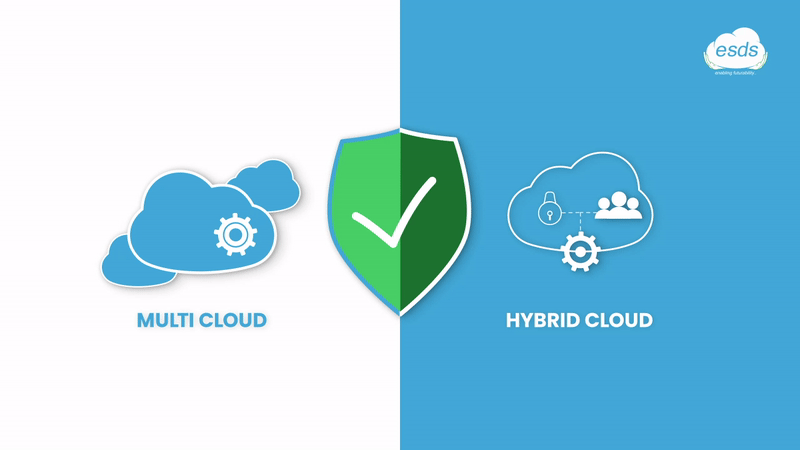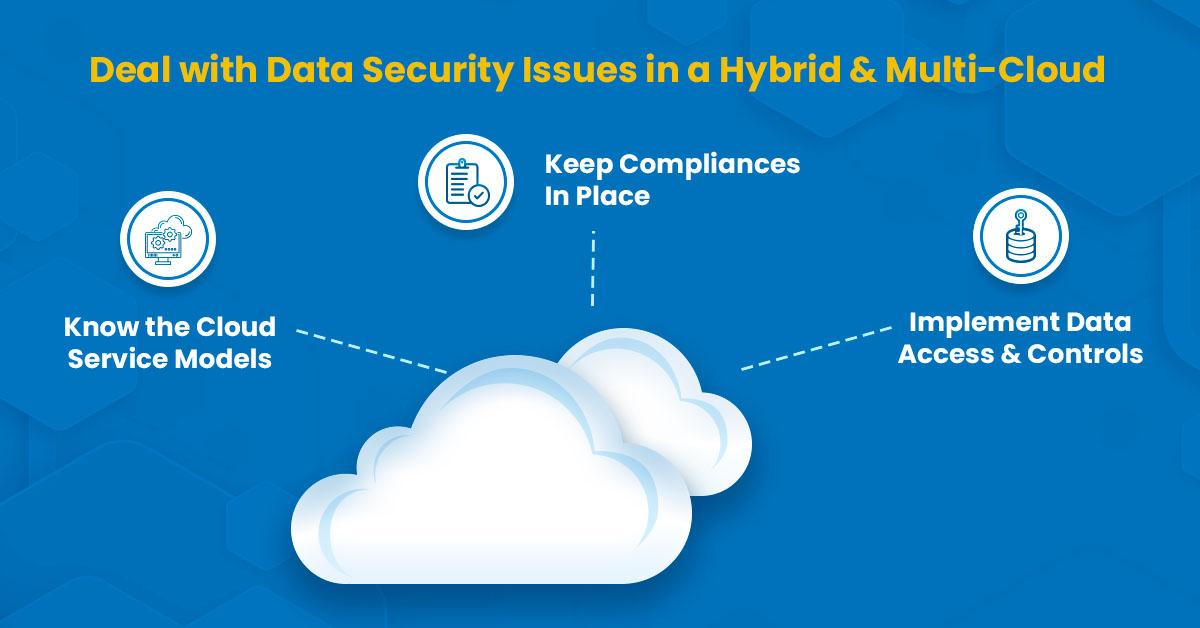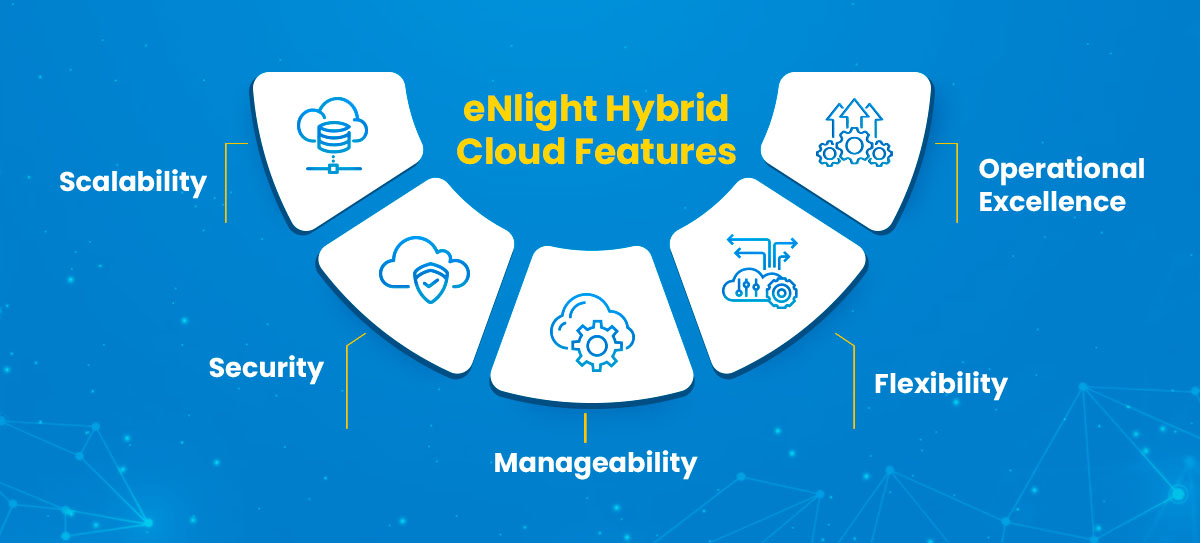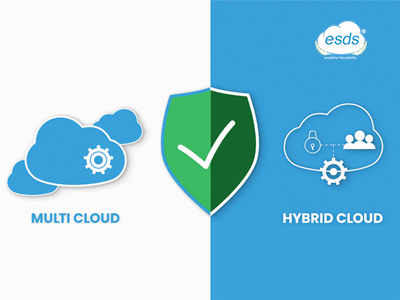How To Secure Your Data in Hybrid & Multi-Cloud Environment?

According to cloud computing statistics, 74% of enterprises use a hybrid and multi-cloud strategy today. 69% of organizations were planning to use a multi-cloud environment. 62% of public cloud adopters are using more than two cloud environments and platforms. Despite all of this, only a small percentage of businesses optimize their cloud spending, which prevents them from utilizing their cloud infrastructure to its full potential.
As they continue to introduce complex interconnected networks, multi-cloud and hybrid cloud environments risk losing visibility. You might not have a single point of control as a result of this. Further complicating matters is a lack of knowledge and understanding of how data flows. How can these cloud challenges be solved? How can you safeguard your data in such a setting?
Read on to know how to deal with data security issues in a hybrid multi-cloud setup.

1. Take A Deep Dive into Cloud Service Model
Since five to ten years, cloud computing has undergone a significant evolution. It is now among the most crucial tools for the digital transformation. You are more likely to select the incorrect cloud service model for your company and underutilize your cloud investments if you lack a thorough understanding of the various cloud service models. It is crucial to comprehend the various cloud service models for this reason.
Four different types of cloud service models exist.
- Software as a Service
- Infrastructure as a Service
- Platform as a Service
- Database as a Service
Let’s examine each one in greater detail.
Software as a Service:
The Software as a Service model outsources all IT, allowing businesses to concentrate more on enhancing their core competencies rather than allocating time and money to maintaining technology. A service provider is in charge of hosting applications and making them accessible to various organisations under the SaaS cloud service model.
Infrastructure as a Service
Organizations can use infrastructure as a service to maintain their physical software, middleware platforms, and business applications on the infrastructure that service providers have made available to them. The service provider also oversees this infrastructure. When businesses need to leverage the cloud while minimizing impact and utilizing existing investments, this service model may come in handy.
Platform as a Service
Through Platform as a Service, businesses can use the infrastructure, middleware, or software that the service provider manages and provides. This lessens the workload on the IT team and enables them to concentrate on creating innovative business applications. It shortens your time to market due to its economic development. Users can also take advantage of opportunities for scalability and develop for multiple platforms.
Database as a Service
A hosted and fully managed database environment is provided by the cloud service provider in the database as a service cloud service model. Improved security and tracking capabilities, quick provisioning, and cost savings make it a good option for businesses that prioritizes security scalability and cost.
Moving from IaaS to DBaaS, makes gets you tend to lose control and have to put your trust in others. Your risk of data security might rise as a result. Even worse, the majority of cloud service providers use a shared responsibility model, which means that your data’s security is not solely their responsibility. Users must also play their part. On the brighter side, users of the infrastructure as a service model can implement security measures; however, SaaS and other service models require them to rely on cloud providers.
2. Data Access and Control
Enterprises must adopt a unified approach to hybrid and multi-cloud security due to the rapidly changing threat landscape if they want to protect their data. You must reflect on some crucial issues for this, including:
- What data will be moved to the cloud?
- What data is stored on-premise servers?
- What are the security vulnerabilities you should focus on?
You’ll have a better understanding of your data needs after responding to these questions. This makes it possible for you to implement contextual data access controls based on the types of data and the storage location of the data. Consequently, you create data access policies, to implement tokenization, encryption, data masking, data blocking, and data redaction. What’s more, you can choose the right level of protection based on your security and compliance needs. Due to this, your controls aren’t increasing friction or making it challenging for users to access the data.
3. Accelerate Compliance
It is no longer sufficient to merely adhere to industry-specific standards. Businesses will need to look beyond these benchmarks. Your data is subject to privacy laws because it is spread across multiple clouds.
Let’s imagine that a public cloud is where your data is stored. It’s crucial for businesses to understand how a service provider will safeguard their private customer information. Consider the case where your data includes sensitive information about users’ finances, race, and ethnicity that may be subject to particular processing conditions and requirements. Does your cloud service provider meet these demands? If the answer is no, you would be better off looking elsewhere because it could jeopardize your sensitive business information. You as a company don’t want that information to get out.
Regardless of the cloud service model you select, it is crucial to prioritize data security. On-premises or in the cloud, data security, privacy, and compliance controls should be in place if your sensitive business data is stored in multiple clouds to keep it secure. Control access and only give users roles that are appropriate for their tasks. This reduces the possibility of abuse and eliminates internal threats. To protect your data from outside threats, raise employee awareness and implement firewalls, antivirus software, and other security measures.
Leading the Way in Hybrid & Multi-Cloud Security

eNlight Hybrid Cloud by ESDS combines the strengths of public and private cloud environments to create a scalable, secure, and easily manageable architecture for optimizing business operations. With enhanced flexibility provided by ESDS, organizations can efficiently prioritize their workloads between public and private cloud platforms, enabling them to achieve operational excellence.
Do you use hybrid or multi-cloud? If yes, how do you keep your data secure in a hybrid multi-cloud environment?
Share your insights in the comments and be a part of the conversation!
- 6 Ways AI Reinvents the Security Landscape - January 9, 2024
- Top 6 Current Cybersecurity Trends For 2024 - January 9, 2024
- What Have We Learned from The Recent Cybersecurity Incidents? - January 3, 2024
